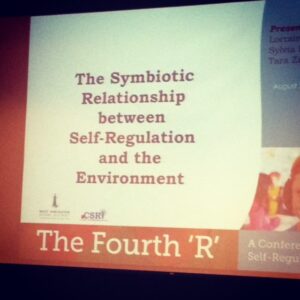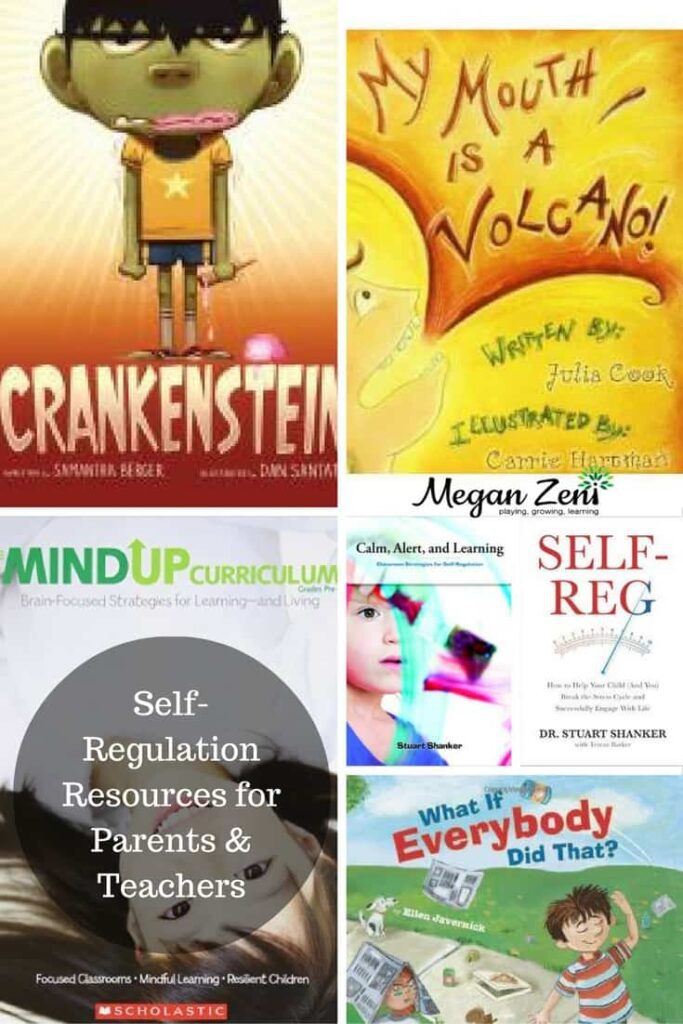- filed under: Play Research
Self-Regulation in the Classroom
In 2014, I attended the ‘Fourth R’ Conference jointly hosted by the West Vancouver school district and the Canadian Self Regulation Initiative. This conference focused on why the Fourth ‘R’ in education (self-regulation) is as important to school success as the traditional 3 R’s (reading, writing and arithmetic)
If you missed the event, these are the big ideas I walked away with!
From Dr. Shanker’s conversation with West Vancouver Superintendent, Chris Kennedy:
- Self-regulation is a process, not a program. Children need to be taught, and have opportunities to practice, what it feels like to be self regulated before they can be expected to achieve it on their own.
- Quite frankly, children are incapable of self-regulation unless the adults around them have achieved it and can model it for them. The process of self-regulation in children begins with ourselves!
- There are over 400 definitions of self-regulation! Dr. Shanker defined it as: how the brain responds to stress and then recovers.
- Living in a state of perpetual stress wears out the recovery mechanism of the brain, which makes it difficult to bring a child into recovery mode and ultimately decreases the child’s resiliency.
- A partnership between parents and teachers is essential. Blaming one or the other for a child’s difficulties puts the child in a state of stress and does nothing to support self-regulating awareness.
- The brain is designed to respond to stress or danger with adrenaline. Video games that feel dangerous (those that have an element of danger or threat) ignite the primitive brain’s instinct to fight/ flight. Overexposure to this type of stress overwhelms the brain’s ability to recover from stress, which leads to difficulties with self-regulation. When the game is over the body is still in fight/ flight mode and is incapable of processing, learning, or self-regulating until it is back in recovery mode.
- The primitive brain is a solitary creature. Children must be brought back to social engagement for self-regulation to occur.
- Dr. Shanker was quite firm that there should be no exposure to any light emitting screens 1-2 hours before bedtime. This unnatural light interrupts the restorative sleep required for healthy self-regulation. Studies show that even e-readers impact the brain’s ability to rest and recover!
- Over tired kids are much more at risk for impulsive, risky behaviours. Restorative sleep is more important than the length of sleep.
- Children who are pleasant and keen to take on the day show good self-regulation.
- Children who struggle to recover from moodiness, irritability and hyper or hypo states of arousal are showing symptoms of an overstressed recovery system.
- The first three years are critical for setting the brain’s reactivity to stress. Children who miss the opportunity to self-regulate in those years develop hyper or suppressed alarm systems and will have low energy.
- It’s never too late to learn to self–regulate! At any age, we can be taught to discover what soothes us and then to recognize the signs of losing regulation while seeking out a self-soothing solution.
- It is critical that children have a calming environment to go to when they need to depressurize and self-regulate. Many children are overwhelmed by noise, lights and visual distractions. Frequently, the bedroom is a place of recovery for children and where children go at the end of the day to decompress.
- Signs of heightened stress reactivity include a hair trigger stress response, increased immune system problems and difficulties with attention.
- The school is the strongest resource for creating a healthy society.
- Gardening is a good activity for developing self-regulation (be sure to check out The Classroom Gardener for school gardening resources here)
- Click here to purchase Dr. Shanker’s book: Calm, Alert and Learning.
From “The symbiotic Relationship Between Self-regulation and the Environment” with presenters Sylvia King, Lorraine Hartley and Tara Zielinski:
- Less choice is often easier for children with difficulties self-regulating.
- Less clutter invites conversation, creativity and reflection.
- In classrooms, tables, rather than individual desks, reduce the visual clutter.
- Children who are self regulated are able to: pay attention even when it is hard, get along with others and struggle through a challenge to learn something new.
- The “Zones of Regulation” and “Mind Up” were useful for implementing self-regulation strategies into their classrooms.
- Social stories, visual timers and routines with expectations all make classrooms easier for children who struggle to be calm, alert and focused.
From “Human Development, Self-regulation and the Magic Six” with Sandra- Lynn Shortall and Moray Mclean:
- In order to self-regulate, and be ready to learn, a child must have a healthy attachment with a caring adult.
- Children who feel safe and secure have well developed brains and are more playful with higher academic success.
- To feel safe and secure children need an environment that is physically and emotionally safe, a place to call their own and is rich with routines and rituals. Environments that support well being support self-regulation.
- Play is essential for healthy social and emotional development. Children construct knowledge through high challenge, but low stress activities.
- Physically demanding play is protective and has a regulating influence on mental health.
- Play provides opportunities for increased self- awareness, the building block for self-regulation.
- Parents and other adults can model self-regulation for children by explaining their feelings, “Mommy is tired and cranky because there was a lot of traffic today and sitting in the hot car for so long was hard for me”.
- Environments that support kindness and compassion result in humans who are more resilient and able to self-regulate, even in the most challenging contexts. Great quote: “We are all vulnerable, the question is whether your vulnerability was protected” G. Mate.
There are loads of resources available online if you are interested in learning more. For teachers, I recommend the Mind Up series, as well as Shanker’s Calm, Alert and Learning. His new book, Self-Reg helps parents break the stress cycle and successfully engage in life.
There are many picture books that address self-regulation challenges as well. Start with What if Everybody Did That? As well as My Mouth Is A Volcano and Crankenstien. What books do you recommend?
If you are interested in learning more about self-regulation, come follow me on Pinterest for classroom ideas and tips:


